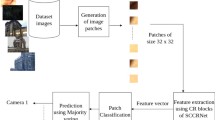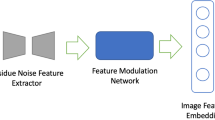Abstract
Source Camera Identification is a well-known digital forensic challenge of mapping an image to its authentic source. The current state-of-the-art provides a number of successful and efficient solutions to this problem. However, in almost all such existing techniques, a sufficiently large number of image samples is required for pre-processing, before source identification. Limited labels classification is a realistic scenario for a forensic analyst where s/he has access only to a few labelled training samples, available for source camera identification. In such contexts, where obtaining a vast number of image samples (per camera) is infeasible, correctness of existing source identification schemes, is threatened. In this paper, we address the problem of performing accurate source camera identification, with a limited set of labelled training samples, per camera model. We use a few shot learning technique known as deep siamese network here, and achieve significantly improved classification accuracy than the state–of–the–art. Here, the main principle of operation is to form pairs of samples from the same camera models, as well as from different camera models, to enhance the training space. Subsequently, a deep neural network is used to perform source classification. We perform experiments on traditional camera model identification, as well as intra–make and intra–device source identification. We also show that our proposed methodology under limited labels scenario, is robust to image transformations such as rotation, scaling, compression, and additive noise.




Similar content being viewed by others
Notes
The imnoise() function of MATLAB is used in our work for additional noise.
References
Akshatha K, Karunakar A, Anitha H, Raghavendra U, Shetty D (2016) Digital camera identification using prnu: a feature based approach. Digit Investig 19:69–77
Bayram S, Sencar HT, Memon N (2015) Sensor fingerprint identification through composite fingerprints and group testing. IEEE Trans Inf Forensics Secur 10(3):597–612
Berlemont S, Lefebvre G, Duffner S, Garcia C (2018) Class-balanced siamese neural networks. Neurocomputing 273:47–56
Bondi L, Baroffio L, Güera D, Bestagini P, Delp EJ, Tubaro S (2017) First steps toward camera model identification with convolutional neural networks. IEEE Signal Process Lett 24(3):259– 263
Ċeliktutan O, Sankur B, et al. (2008) Blind identification of source cell-phone model. IEEE Trans Inf Forensics Secur 3(3):553–566
Chen C, Stamm MC (2015) Camera model identification framework using an ensemble of demosaicing features. In: Information forensics and security (WIFS), 2015 IEEE international workshop on. IEEE, pp 1–6
Chen M, Fridrich J, Goljan M, Lukás J (2008) Determining image origin and integrity using sensor noise. IEEE Trans Inf Forensics Secur 3 (1):74–90
Chopra S, Hadsell R, LeCun Y (2005) Learning a similarity metric discriminatively, with application to face verification. In: Computer vision and pattern recognition, 2005. CVPR 2005. IEEE computer society conference on, vol 1. IEEE, pp 539–546
Dirik AE, Sencar HT, Memon N (2008) Digital single lens reflex camera identification from traces of sensor dust. IEEE Trans Inf Forensics Secur 3(3):539–552
Dirik AE, Sencar HT, Memon N (2014) Analysis of seam-carving-based anonymization of images against prnu noise pattern-based source attribution. IEEE Trans Inf Forensics Secur 9(12):2277– 2290
Fei-Fei L, Fergus R, Perona P (2006) One-shot learning of object categories. IEEE Trans Pattern Anal Mach Intell 28(4):594–611
Gloe T (2012) Feature-based forensic camera model identification. In: Transactions on data hiding and multimedia security VIII. Springer, pp 42–62
Gloe T, Böhme R (2010) The dresden image database for benchmarking digital image forensics. J Digit Forensic Prac 3(2-4):150–159
Goljan M, Fridrich J, Filler T (2009) Large scale test of sensor fingerprint camera identification. In: Media forensics and security. International society for optics and photonics, vol 7254, p 72540i
Hadsell R, Chopra S, LeCun Y (2006) Dimensionality reduction by learning an invariant mapping. In: Computer vision and pattern recognition. 2006 IEEE computer society conference on, vol 2. IEEE, pp 1735–1742
Huang Y, Zhang J, Huang H (2015) Camera model identification with unknown models. IEEE Trans Inf Forensics Secur 10(12):2692–2704
Karaküċük A, Dirik AE (2015) Adaptive photo-response non-uniformity noise removal against image source attribution. Digit Investig 12:66–76
Kharrazi M, Sencar HT, Memon N (2004) Blind source camera identification. In: Image processing, 2004. ICIP’04. 2004 international conference on, vol 1. IEEE, pp 709–712
Koch G (2015) Siamese neural networks for one-shot image recognition. In: 32nd international conference on machine learning. International machine learning society, vol 37
Lawgaly A, Khelifi F (2017) Sensor pattern noise estimation based on improved locally adaptive dct filtering and weighted averaging for source camera identification and verification. IEEE Trans Inf Forensics Secur 12(2):392–404
Li CT (2010) Source camera identification using enhanced sensor pattern noise. IEEE Trans Inf Forensics Secur 5(2):280–287
Lin X, Li CT (2016) Preprocessing reference sensor pattern noise via spectrum equalization. IEEE Trans Inf Forensics Secur 11(1):126–140
Lin X, Li CT (2017) Large-scale image clustering based on camera fingerprints. IEEE Trans Inf Forensics Secur 12(4):793–808
Lukas J, Fridrich J, Goljan M (2006) Digital camera identification from sensor pattern noise. IEEE Trans Inf Forensics Secur 1(2):205–214
Marra F, Poggi G, Sansone C, Verdoliva L (2016) Correlation clustering for prnu-based blind image source identification. In: Information forensics and security (WIFS). 2016 IEEE international workshop on. IEEE, pp 1–6
Marra F, Poggi G, Sansone C, Verdoliva L (2017) Blind prnu-based image clustering for source identification. IEEE Trans Inf Forensics Secur 12(9):2197–2211
Marra F, Poggi G, Sansone C, Verdoliva L (2017) A study of co-occurrence based local features for camera model identification. Multimed Tools Appl 76(4):4765–4781
Sabri M, Kurita T (2018) Facial expression intensity estimation using siamese and triplet networks. Neurocomputing 313:143–154
Shullani D, Fontani M, Iuliani M, Al Shaya O, Piva A (2017) Vision: a video and image dataset for source identification. EURASIP J Inf Secur 2017(1):15
Tan Y, Wang B, Li M, Guo Y, Kong X, Shi Y (2015) Camera source identification with limited labeled training set. In: International workshop on digital watermarking. Springer, pp 18–27
Thai TH, Retraint F, Cogranne R (2015) Camera model identification based on dct coefficient statistics. Digit Signal Process 40:88–100
Thai TH, Retraint F, Cogranne R (2016) Camera model identification based on the generalized noise model in natural images. Digit Signal Process 48:285–297
Tuama A, Comby F, Chaumont M (2015) Source camera model identification using features from contaminated sensor noise. In: International workshop on digital watermarking. Springer , pp 83–93
Tuama A, Comby F, Chaumont M (2016) Camera model identification with the use of deep convolutional neural networks. In: IEEE International workshop on information forensics and security , pp 6–pages
Tuama A, Comby F, Chaumont M (2016) Camera model identification with the use of deep convolutional neural networks. In: IEEE International workshop on information forensics and security, pp 6–pages
Xu B, Wang X, Zhou X, Xi J, Wang S (2016) Source camera identification from image texture features. Neurocomputing 207:131–140
Xu G, Shi YQ (2012) Camera model identification using local binary patterns. In: Multimedia and expo (ICME). 2012 IEEE international conference on. IEEE, pp 392–397
Yang Y, Saleemi I, Shah M (2013) Discovering motion primitives for unsupervised grouping and one-shot learning of human actions, gestures, and expressions. IEEE Trans Pattern Anal Mach Intell 35(7):1635–1648
Zeng H (2016) Rebuilding the credibility of sensor-based camera source identification. Multimed Tools Appl 75(21):13871–13882
Author information
Authors and Affiliations
Corresponding author
Additional information
Publisher’s note
Springer Nature remains neutral with regard to jurisdictional claims in published maps and institutional affiliations.
Rights and permissions
About this article
Cite this article
Sameer, V.U., Naskar, R. Deep siamese network for limited labels classification in source camera identification. Multimed Tools Appl 79, 28079–28104 (2020). https://doi.org/10.1007/s11042-020-09106-y
Received:
Revised:
Accepted:
Published:
Issue Date:
DOI: https://doi.org/10.1007/s11042-020-09106-y




